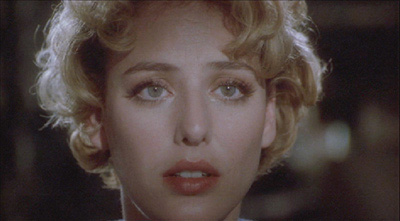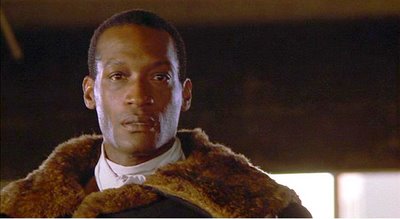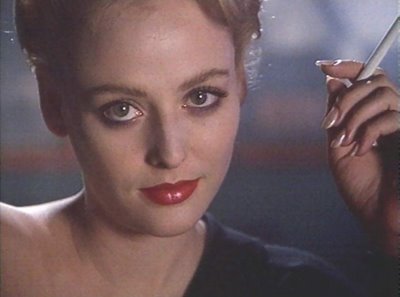Sweets to the Sweet: Urban Myth and the Majesty of Candyman
“How do you do? I see you’ve met my faithful handyman.
He’s just a little brought down because when you knocked
He thought you were the Candyman.”
–The Rocky Horror Picture Show
Urban Legend: It has a fine ring to it, I’ve always thought. We’ve all listened to one, half enthralled and half with amusement. Hell, we’ve probably all told one; sometimes knowing what we’re repeating, sometimes thinking that we are being totally original. Myself, I’ve often spun the one about the young girl who’s on holiday with her parents when she is bitten by some insect on the beach. When she gets home, the bite is still bothering her a bit and is now red and swollen. Still she isn’t too concerned about it. Then one evening as she is taking a hot bath her parents hear her uncontrollable screaming. They rush to the bathroom and…
What has seemed like a bite was in fact some hideous spider stinging through the flesh of her arm in order to lay its eggs. Now the warm water of the bath has done its work. The eggs have hatched and dozens of baby spiders are emerging from her body, marching down the length of her arm as she screams and screams…
I’ve no idea where I first heard that. I think I might have read it in a newspaper. Or maybe it was passed on to me by a friend who had a friend who actually knew the girl that it happened to. I have no idea whether this really took place or not; but if I got it from the newspaper or the friend who had a friend, well…it has to be true, doesn’t it?
In Bernard Rose’s brilliantly creepy 1992 film Candyman he draws heavily on our fascination with all the staple trappings of urban myths: the babysitter, who is messing around with her boyfriend instead of concentrating on what she’s supposed to be doing; the unanswered or ignored 911 calls; and of course the inevitable appendage. In this case it’s…oh, a hook don’t you know?
Working from his own screenplay, which in turn is inspired by Clive Barker’s short story ‘The Forbidden’, what Bernard Rose gives us is a modern horror film classic; and one that rises far above what could in other hands have been standard slasher fare. What prevents this film from ever being in any way ordinary are a number of factors: a cracking screenplay, of course; a wonderful and unusual choice of soundtrack; a truly charismatic bogey man; and the kicker, an outstanding tour-de- force of a performance from the leading lady Virginia Madsen.
Now, I have to nail my prejudices firmly to the mast here. To my mind Madsen is one of the most criminally underused actresses around. I just don’t understand why she hasn’t become more of a name than she has. As far as I’m concerned, if the industry wasn’t so ill disposed to giving major awards to horror movies she would at the very least have been nominated for this one, rather than having to wait another twelve years before her Academy Award and Golden Globe nominations for Alexander Payne’s wonderful Sideways, a film that incidentally highlights her range. Look: in Dennis Hopper’s desert noir thriller The Hot Spot she is just unforgettable as the ambitious, murderous and manipulative small-town girl with other ideas on her mind. This is a performance that should have seen her easily join the ranks of other femme fetales such as Barbara Stanwycke in Double Indemnity, Kathleen Turner in Body Heat or Linda Fiorentino in The Last Seduction. I mean, she should have easily joined them. Perhaps it was only the weak reception to director Hopper’s movie that didn’t have more people coming out of the cinema mumbling: “Who the hell was that?”
In The Hot Spot she just oozes sexuality. And you have to ask yourself: would I take a chance, given that she might as well have REALLY BAD TROUBLE tattooed across that killer chest? Surely every straight guy in the audience was asking that. And then you take a deep breath and look at her in Sideways. Sure, she is still beautiful, but this time she comes across as so vulnerable and easily damaged that you just want to put an arm around her and tell her that everything is going to be all right. This is a terrific actress.
‘I am the writing on the wall, the whisper in the classroom.’
In Candyman she plays Helen Lyle, a graduate student at Chicago’s University of Illinois. Along with her friend and fellow student Bernadette Walsh (Kasi Lemmons) they are working on a thesis dealing with urban myths, which are summed up by her philandering and rather slimy lecturer husband Trevor, played by Xander Berkely: “These stories are modern oral folklore; the unselfconscious reflection of the fears of urban society”.
So now you know.
They soon come to focus on events at Cabrini-Green, a run-down and gang-ridden high rise housing project, or “Candyman Country” as Purcell, a professor who has written extensively on the myth, puts it. [Just as an aside, I’d like to have seen more of this guy. As played by Michael Culkin he comes across as a rather memorable incarnation of an illustration from a book of nineteenth century political caricatures: rotund, long-haired and on the annoyingly smug side.] In order to invoke Candyman you simply have to look into the mirror and say his name five times. And you know that’s something that Helen is just going to have to do. Otherwise we wouldn’t have a movie.
OK. It’s here that a piece like this unavoidably should give a SPOILER ALERT. So consider yourselves warned.
Helen’s investigations inadvertently lead to the imprisonment of a thug who uses the name of Candyman to instil fear in people towards his gang, The Overlords. And here it gets really fascinating. When the real Candyman shows up it becomes obvious that he exists only because of the beliefs of those who listen to his urban myths.
So do the Gods only exist because enough people believe them to? Is Jesus on a roll at the moment whilst Odin is out on his ass? It’s a fascinating concept (and one that Neil Gaiman more recently used in his novel American Gods). As Candyman explains, almost soothingly to Helen:
“I am the writing on the wall, the whisper in the classroom. Without these things I am nothing… Your disbelief destroyed the faith of my congregation. Without them I am nothing…” And later:
“It is a blessed existence, believe me: to be whispered about at street corners, to live in other peoples’ dreams, but not to have to be.”
‘What do the good know, except what the bad teach them by their excesses?’
After experiencing Tony Todd’s performance it is impossible to imagine anyone else in the part. He is enormously seductive, carrying himself imperiously, speaking in tones that are almost aristocratic. We already know from Purcell that Candyman was the son of a slave who won his freedom; and that he was sought after for his skills as an artist. It was only in 1890, after he had fallen in love with a woman he had been commissioned to paint and had gotten her pregnant, that he was given a terrible death by louts in the pay of her father: his right hand being cut off and replaced by a hook before he was dragged to a hive, covered with bees and stung to death. We know that he is a monster and a cold-blooded killer of the genuinely guiltless and yet it’s hard not to respond to him, even when he comes out with a line like: “What do the good know, except what the bad teach them by their excesses?”
Rose is blessed with a uniformly excellent supporting cast that includes Vanessa Williams as a single mother from the projects who is trying to raise her child as decently as she can. It’s in part some of these social subtexts that distinguish this movie from the herd. There is also a frighteningly mature performance from a young boy called Jake (DeJuan Guy) who has, as the saying goes, ‘an old head on young shoulders’. It’s Jake who is the eyes of the community. This kid misses nothing. And he is the one who leads the people of the projects in the final conflagration in which Candyman and Helen burn; just as he leads them to…do what? To honour Helen at her funeral? It is Jake who drops the hook of Candyman into the grave. Again, to do what? To summon her as a replacement?
The soundtrack is a stroke of genius, as was Rose’s idea to approach Philip Glass (at least I’m assuming it was the director’s idea). Glass is one of my favourite modern composers and of course his contribution to cinema scores forms only the tiniest part of his output; but there are films that it is impossible to imagine without his repetitive, throbbing notes and Paul Schrader’s Mishima: a Life in Four Chapters immediately springs to mind. Glass may have been surprised at being asked to score a horror film but his work suits the eerie feel of Candyman perfectly. And that’s another thing: this is a film for those who like subtlety with their horror movies and yet with enough bloody scenes to satisfy the most demanding reader of Fangoria. Witness one very powerful scene where Helen is forced to strip off her blood-drenched bra and underwear under the totally hostile stare of a police woman who looks tough enough to rip the head off a buffalo. She is literally covered in the gore of a decapitated dog and as she shakes uncontrollably and begs to be allowed a shower it’s almost impossible to remember that this is someone acting.
[By the way, you can hear Glass’s main theme elsewhere on this blog.]If memory serves me right, David Cronenberg once made the curious observation that his film of The Dead Zone was, as much as anything, about Christopher Walken’s’ face. I wasn’t really sure about what he meant until I re-watched the Rose film recently. For one of the main things that Candyman is about is definitely Virginia Madsen’s face; and doesn’t the camera just love it. In close up, hers is the first face we see, dominated by those astonishing eyes. And it is one of the many close shots that we see throughout the movie, especially when she is coming under the influence of Candyman.
Bizarrely, Rose had asked her to be hypnotised for a few of the scenes as he wanted her eyes to remain dilated in some. After a couple of times she quite sensibly called a halt to this nonsense. She’s too good an actress to need to do that; although having said this it is effective in those close shots; and incidentally the actress has one green eye—the right one—whilst the other is a mixture of green and brown.
And the final shot of the film, as the end credits role and we hear Glass’s haunting music for the last time, is of a painted rendition of her face on one of the high-rise walls. She’s joined the scrawls of graffiti such as SWEETS TO THE SWEET; IT WAS ALWAYS YOU, HELEN and depictions of the terrible end of the Candyman himself. Helen has joined the ranks of the immortals, of those who are whispered about in the classrooms and at the street corners. And the film quite rightly ends with the camera moving in on her flame-engulfed figure, her hair ablaze and finally ending on those strange eyes.
Still, it’s just an urban legend, a story to be told around the camp fire. Why am I so sure? Because I’ve tried saying Virginia Madsen’s name into my bedroom mirror on many occasions. And she’s never shown up once.
Not once.




Recent Comments